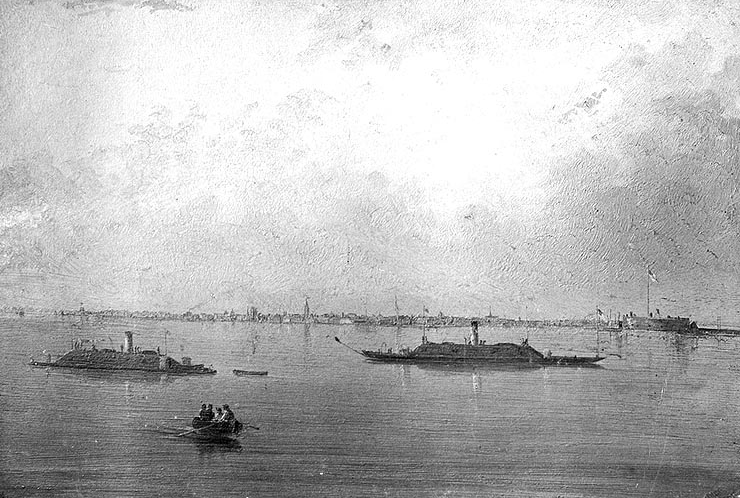 |
| CSS Chicora |
In the first months of 1862, two Confederate ironclad rams were begun in Charleston. They were designed by John L. Porter, one of the builders of the Virginia. Their construction was payed for by contributions from the women of South Carolina. They were 170 feet long, and covered in several inches of iron. The CSS
Chicora and the CSS
Palmetto State were ready by fall.
 |
| Gunboats in the harbor |
The gunboats went out to attack the blockading squadron on the night of January 30th. They chose that day because one of the most important ships of the war had just been captured by the blockaders. It was a British ship carrying many military supplies, including engines for two other ironclads under construction. They hoped to recapture the blockade runner before it was sailed North. The Union blockading squadron off the harbor at the time was 10 ships, but they were wooden and lightly armed, intended to only deal with blockade runners. The commander of the
Palmetto State reported this on the ensuing battle:
As we approached the bar, about 4 A.M., we saw the steamer Mercedita lying at anchor a short distance outside it...the men stood silently at their guns...they did not see us until we were very near. Her captain hailed us, and ordered us to keep off or he would fire... we struck him on the starboard warter, and dropping forward part-shutter, fired the bow gun. The shell from it, according to Captain Stellwagen who commanded her, went through her diagonally, penetrating the starboard side, ... through the seam-drum of the port boiler, and exploded against the port side of the ship, blowing a hole in its exit four or five feet square.
For a Civil War ship, a shot through the boiler was very destructive. The scalding steam was released, and it flowed through the ship burning the crew, and without the boiler the ship could no longer be controlled. The
Mercedita was unable to defend itself because its guns could not aim low enough to strike the Confederate ironclads, which rode low in the water. With no other alternative, the
Mercedita was surrendered to the Confederacy.
 |
| USS Mercidita |
The CSS
Chicora did just as well as its sister ship. It moved on the
Keystone State, and one of its first shots pierced the
Keystone State's boiler, killing and wounding 40 men. The
Keystone State lowered its flag, indicating its surrender. The captain of the
Chicora ordered a boat to be sent to take over the prize. He wrote:
While the boat was in the act of being manned I discovered that she was endeavoring to make her escape by working her starboard wheel, the other being disabled, her colors down. I once started in pursuit and renewed the engagement. Owing to superior steaming qualities she soon widened the distance to some 200 yards. She then hoisted her flag and commenced firing her rifled guns, her commander, by this faithless act, placing herself beyond the pale of civilized and honorable warfare.
After this dishonorable act, there was a bout of long range firing with the other Union ships and the battle was broken off at 7:30. The two small ironclads had broken the blockade around Charleston. However, it did not last long. As soon as the news reached the Federal high command, they sent the USS
New Ironsides and several sister ships of the Monitor, and the blockade was reestablished since the two small ironclads were no match for the larger Northern ships. If the blockade was to be permanently broken by the Confederacy something more would be needed.
 |
| USS Keystone State |






0 comments:
Post a Comment